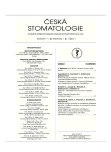Caries Experience of Patients with Special Needs without the Treatment Under General Anaesthesia in Comparison with Other International Studies
Authors:
M. Staňková; A. Buček; J. Feberová; T. Dostálová; K. Ginzelová
Authors‘ workplace:
Dětská stomatologická klinika 2. LF UK a FN Motol, Praha
Published in:
Česká stomatologie / Praktické zubní lékařství, ročník 111, 2011, 1, s. 17-23
Category:
Original Article – Retrospective Essay
Overview
Purpose:
The study evaluates the results obtained from the health care records of patients with special needs, who have undergone treatment under general anaesthesia at the Paediatric dentistry department in Prague. Dmft (decayed – missing – filled- teeth) was used for comparison.
Materials and Methods:
A sample of 1836 children (1123 boys and 713 girls) from our dental department was evaluated. The sample was divided into two groups – special patient and disabled patient populations. A group of 5 years old children was chosen based on the WHO guidelines for assessing the oral health status. A questionnaire was prepared to compare the oral health habits in the families of the patients. A literary review was conducted to compare the results with other studies from different countries.
Results:
The DMFT of the patients was counted (disabled DMFT 11. 05 – SD 4. 82, special patient population 8. 8- SD 3. 7) and the descriptive statistics mean standard deviation was calculated. It was used for the analysis of dispersion. The significant difference between the DMFT of disabled patient and special patient population was exerted /p<0.00003/. The results were compared with the literary review. It was statistically evaluated that the data gained from the studies and from the WHO as population average for 5 years old children are situated under the minimum limit of the confidence interval for our study. 247 questionnaires were collected. Interesting result was that patients from group one in 63% did not visit their dentist before 3 years of age.
Conclusions:
This study proves that the standards for oral health care for special needs patients treated at Motol Hospital in Prague below normal standards.
Key words:
handicapped patient - DMFT - general anaesthesia
Sources
1. Alavi, A. A., Amirhakimi, E., Karami, B.: The prevalence of dental caries in 5 - 18-year-old insulin-dependent diabetics of Fars Province, southern Iran. Arch Iran Med., 9, 2006, č. 3, s. 254-260.
2. American Academy of Pediatric Dentistry. American Academy of Pediatric Dentistry Committee on Sedation and Anesthesia. Guideline on the elective use of minimal, moderate, and deep sedation and general anesthesia for pediatric dental patients. Ped. Dent., 2005-2006, č. 27 (7 Reference Manual), s. 10-18.
3. ASA Physical Status Classification System: http://www.asahq.org/clinical/physicalstatus.html
4. Caputo, A. C.: Providing deep sedation and general anesthesia for patients with special needs in the dental office-based settings. Spec. Care Dentist, 29, 2009, č. 1, s. 26-30.
5. de Jongh, A., van Houtem, C., van der Schoof, M., Resida, G., Broers, D.: Oral health status, treatment needs, and obstacles to dental care among noninstitutionalized children with severe mental disabilities in The Netherlands. Spec. Care Dentist, 28, 2008, č. 3, s. 111-115.
6. Desai, M., Messer, L. B., Calache, H.: A study of the dental treatment needs of children with disabilities in Melbourne, Australia. Aust. Dent. J., 46, 2001, č. 1, s. 41-50.
7. Dougherty, N.: The dental patient with special needs: a review of indications for treatment under general anesthesia. Spec. Care Dentist, 29, 2009, č. 1, s. 17-20.
8. Ivancić Jokić, N., Majstorović, M., Bakarcić, D., Katalinić, A., Szirovicza, L.: Dental caries in disabled children. Coll Antropol., 31, 2007, č. 1, s. 321-324.
9. Jain, M., Mathur, A., Kumar, S., Dagli, R. J., Duraiswamy, P., Kulkarni, S.: Dentition status and treatment needs among children with impaired hearing attending a special school for the deaf and mute in Udaipur, India. J. Oral Sci., 50, 2008, č. 2, s. 161-165.
10. Malamud, S. F.: Sedation: a guide to patient’s management, 4 the ed. St. Louis, MO, Mosby, 2003, s. 428.
11. Nunn, J. H., Gordon, P. H., Carmichael, C. L.: Dental disease and current treatment needs in a group of physically handicapped children. Community Dent Health, 10, 1993, č. 4, s. 389-396.
12. Ohito, F. A., Opinya, G. N.: Wang’ombe J. Dental caries, gingivitis and dental plaque in handicapped children in Nairobi, Kenya. East Afr. Med. J., 70, 1993, č. 2, s. 71-74.
13. WHO:Globaloralhealth:Cariesprevalence: DMFT,DMFS: http://www.whocollab.od.mah.se/ expl/orhdmft.html
14. Wong, F. S.: Planning future general anaesthetic services in paediatric dentistry on the basis of evidence: an analysis of children treated in the Day Stay Centre at the Royal Hospitals NHS Trust, London, between 1985-1995. Int. Dent. J., 47, 1997, č. 5, s. 285.
Labels
Maxillofacial surgery Orthodontics Dental medicineArticle was published in
Czech Dental Journal

2011 Issue 1
- What Effect Can Be Expected from Limosilactobacillus reuteri in Mucositis and Peri-Implantitis?
- The Importance of Limosilactobacillus reuteri in Administration to Diabetics with Gingivitis
Most read in this issue
- Methods of Caries Incipient Well-timed Diagnostics
-
Retence horních středních řezáků
Příčiny retence a srovnání možností léčby - Dental Erosions - Part 1.
- Segner-Hasund Harmony Box in Clinical Practice
